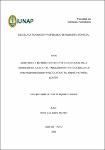| dc.contributor.advisor | Rojas Tuanama, Rildo | |
| dc.contributor.author | Gatica Sánchez, Nilton Luis | |
| dc.date.accessioned | 2017-03-15T17:17:45Z | |
| dc.date.available | 2017-03-15T17:17:45Z | |
| dc.date.issued | 2015 | |
| dc.identifier.uri | http://repositorio.unapiquitos.edu.pe/handle/20.500.12737/4302 | |
| dc.description.abstract | La investigación se realizó en el vivero forestal “Antonio Aróstegui” del Centro de Investigaciones José López Parodi - Jenaro Herrera, Estación Experimental del Instituto de Investigaciones de la Amazonía Peruana, ubicado en la localidad de Jenaro Herrera, con el objetivo de determinar el efecto del ácido indol 3 butírico con diferentes sustratos en la formación de callos y el enraizamiento en estaquillas de Aniba rosaeodora “palo de rosa”. Se emplearon 320 estaquillas, distribuidas en 4 repeticiones por 8 tratamientos (dosis de ácido indol 3 butírico tanto en sustrato de arena blanca como en cascarilla de arroz carbonizada) utilizando un diseño de bloques completamente al azar con arreglo factorial de 2 x 4. Aniba rosaeodora, forma callos entre 15 a 30 días después de la siembra con dosis superiores a 5000 ppm tanto en arena como en cascarilla. Asimismo, se encontraron diferencias significativas en el enraizamiento entre los tratamientos y el factor B, no siendo significativo para el factor A y la interacción AB lo que confirma que los tratamientos en estudio responden indistintamente entre cada uno de ellos al tipo de abono, así como a las tres concentraciones utilizadas (3000, 5000 y 6000 ppm). En los futuros trabajos de investigación es recomendable el uso de cascarilla de arroz carbonizada o arena blanca ya que no difieren estadísticamente. Además usar la dosis 5000 ppm de ácido indol 3 butírico ya que alcanza mayores porcentajes de enraizamiento. | es_PE |
| dc.description.abstract | In order to test the effect of the addition of Indole-3-butyric acid in different substrates in the formation of callus and in the root taking of small stakes of Aniba rosaeodora, a study was conducted in the tree nursery of the Experimental Station of the Research Center Jenaro Herrera of the Peruvian Amazon Research Institute, Jenaro Herrera, Peru. 320 small stakes were distributed in eight treatments with four replications (dose of Indole-3-butyric acid in white sand substrate as well as in carbonized rice husk) using a completely randomized blocks design with a factorial arrangement of 2 x 4. Aniba rosaeodora forms callus after 15 to 30 days of having sowed when using a dose higher than 5000 ppm in sand with husk. Moreover, significant differences were found in the root taking among treatments and the B factor, but no significance were found for the A factor and the AB interaction, proving that tested treatments indistinctly respond among them to the fertilizer type and to the three concentrations utilized (3000; 5000 and 6000 ppm). Due to no statistical significant differences were found when using carbonized rice husk and white sand the use of both substrates is recommended. In addition, the use of the dose of 5000 ppm of Indole-3-butyric acid is recommended since a higher percentaje of root taking were attained. | en_US |
| dc.description.uri | Tesis | es_PE |
| dc.format | application/pdf | es_PE |
| dc.language.iso | spa | es_PE |
| dc.publisher | Universidad Nacional de la Amazonía Peruana | es_PE |
| dc.rights | info:eu-repo/semantics/openAccess | es_PE |
| dc.rights | Attribution-NonCommercial-NoDerivs 3.0 United States | * |
| dc.rights.uri | http://creativecommons.org/licenses/by-nc-nd/3.0/us/ | * |
| dc.source | Universidad Nacional de la Amazonía Peruana | es_PE |
| dc.source | Repositorio Institucional - UNAP | es_PE |
| dc.subject | Sustrato de cultivo | es_PE |
| dc.subject | Ácido indolbutirico | es_PE |
| dc.subject | Formación de la planta | es_PE |
| dc.subject | Enraizamiento | es_PE |
| dc.subject | Esquejes | es_PE |
| dc.subject | Palo rosa | es_PE |
| dc.subject | Aniba rosaeodora | es_PE |
| dc.title | Ácido indol 3 butírico con diferentes sustratos en la formación de callos y el enraizamiento en estaquillas de Aniba rosaeodora Ducke “palo de rosa” en Jenaro Herrera, Loreto. | es_PE |
| dc.type | info:eu-repo/semantics/bachelorThesis | es_PE |
| thesis.degree.discipline | Ingeniería Forestal | es_PE |
| thesis.degree.grantor | Universidad Nacional de la Amazonía Peruana. Facultad de Ciencias Forestales | es_PE |
| thesis.degree.level | Título Profesional | es_PE |
| thesis.degree.name | Ingeniero Forestal | es_PE |
| thesis.degree.program | Regular | es_PE |


